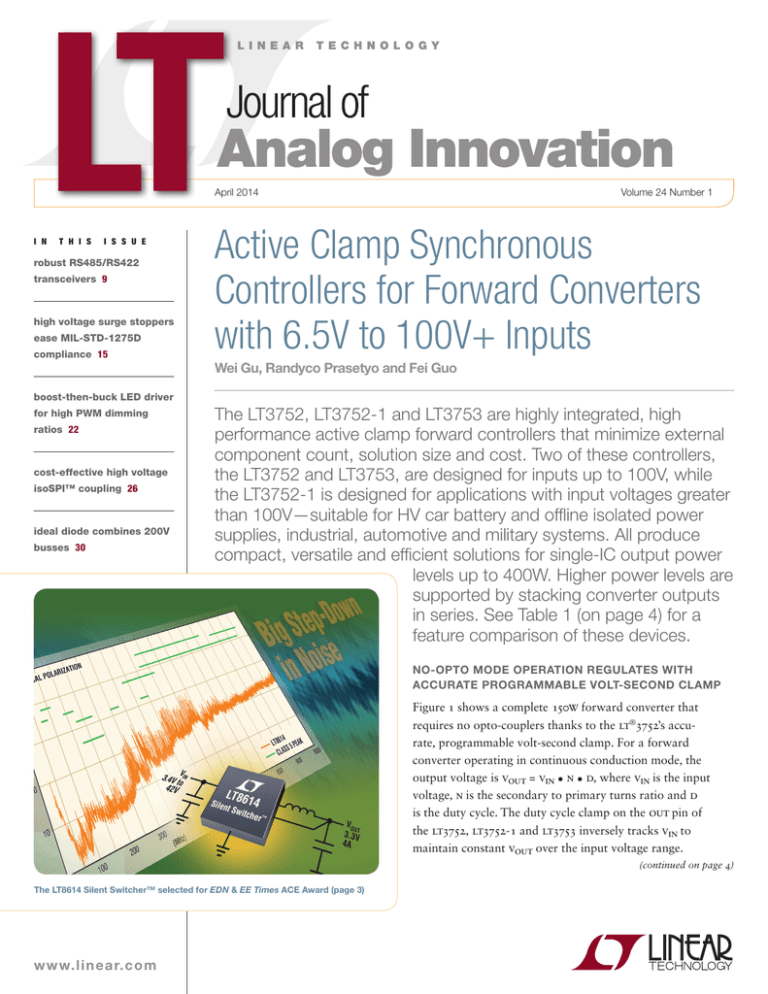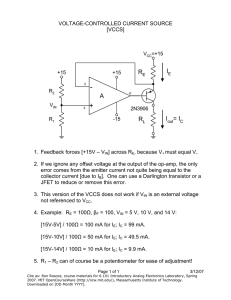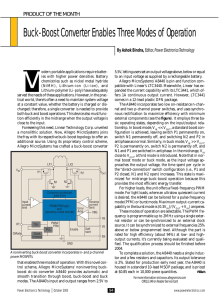Active Clamp Synchronous Controllers for Forward Converters with
advertisement

April 2014 I N T H I S I S S U E robust RS485/RS422 transceivers 9 high voltage surge stoppers ease MIL-STD-1275D compliance 15 Volume 24 Number 1 Active Clamp Synchronous Controllers for Forward Converters with 6.5V to 100V+ Inputs Wei Gu, Randyco Prasetyo and Fei Guo boost-then‑buck LED driver for high PWM dimming ratios 22 cost-effective high voltage isoSPI™ coupling 26 ideal diode combines 200V busses 30 The LT3752, LT3752‑1 and LT3753 are highly integrated, high performance active clamp forward controllers that minimize external component count, solution size and cost. Two of these controllers, the LT3752 and LT3753, are designed for inputs up to 100V, while the LT3752-1 is designed for applications with input voltages greater than 100V—suitable for HV car battery and offline isolated power supplies, industrial, automotive and military systems. All produce compact, versatile and efficient solutions for single-IC output power levels up to 400W. Higher power levels are supported by stacking converter outputs in series. See Table 1 (on page 4) for a feature comparison of these devices. NO-OPTO MODE OPERATION REGULATES WITH ACCURATE PROGRAMMABLE VOLT-SECOND CLAMP Figure 1 shows a complete 150W forward converter that requires no opto-couplers thanks to the LT®3752’s accurate, programmable volt-second clamp. For a forward converter operating in continuous conduction mode, the output voltage is VOUT = VIN • N • D, where VIN is the input voltage, N is the secondary to primary turns ratio and D is the duty cycle. The duty cycle clamp on the OUT pin of the LT3752, LT3752-1 and LT3753 inversely tracks VIN to maintain constant VOUT over the input voltage range. (continued on page 4) The LT8614 Silent Switcher™ selected for EDN & EE Times ACE Award (page 3) Caption w w w. li n ea r.com Table 1. Feature comparison of LT3752, LT3752-1 and LT3753 PART INPUT RANGE ACTIVE CLAMP DRIVER HOUSEKEEPING FLYBACK CONTROLLER LT3753 8.5V–100V Lo-Side No LT3752 6.5V–100V Lo-Side Yes LT3752-1 100V–400V+ Hi-Side Yes (LT375x) continued from page 1) If the resistor that programs the duty cycle clamp goes open circuit, the part immediately stops switching, preventing the device from running without the volt-second clamp in place. In an active volt-second clamp scheme, the accuracy of VOUT depends heavily on the accuracy of the volt-second clamp. Competing volt-clamp solutions use an external RC network connected from the system input to trip an internal comparator threshold. Accuracy of the RC method suffers from external capacitor error, part-to-part mismatch between the RC time constant and the IC’s switching period, the error of the internal comparator threshold and the nonlinearity of charging at low input voltages. The housekeeping supply can be used to overdrive the INTVCC pin to take power outside of the part, improve efficiency, provide additional drive current and optimize the INTVCC level. The housekeeping supply also allows bias to any secondary side IC before the main forward converter starts switching. This removes the need for external startup circuitry on the secondary side. INTEGRATED HOUSEKEEPING FLYBACK CONTROLLER The LT3752/LT3752-1 includes an internal constant frequency flyback controller for generating a housekeeping supply. The housekeeping supply can efficiently provide bias for both primary and secondary ICs, eliminating the need to generate bias supplies from auxiliary windings in the main forward transformer, significantly reducing transformer complexity, size and cost. To ensure accurate regulation part to part, the LT3752, LT3752-1 and LT3753 feature trimmed timing capacitor and comparator thresholds. Figure 2 shows VOUT versus load current for various input voltages. PRECISION UNDERVOLTAGE LOCKOUT AND SOFT-START The precision LT3752/LT3752-1 undervoltage lockout (UVLO) feature can be used for supply sequencing or start-up overcurrent protection—simply apply a resistor divider to the UVLO pin from the VIN supply. Figure 1. 150W forward converter in No-Opto mode VIN 18V TO 72V INTVCC 4.7µF 100V ×3 D2 • T2 2.2µF • VAUX D3 • 2.2µF • T1 4:4 L1 6.8µH • 20k D4 15nF Si2325DS 100nF M2 499Ω 0.15Ω 10k M4 M3 LT3752 OVLO 1.82k 22.6k 34k 31.6k 49.9k 7.32k 60.4k 4 | April 2014 : LT Journal of Analog Innovation 22nF 0.33µF • 560Ω 22nF COMP FB 2.8k CSW FB VAUX 4.7µF 499k 4.7µF 1.1k CSN CSP PGOOD SYNC T3 INTVCC HFB LT8311 GND 10k HCOMP SS2 SS1 RT TBLNK IVSEC TAS TOS TAO GND • 220pF SOUT INTVCC VIN 2.2nF SS ISENSEN RSENSE 0.006Ω 2.2µF 100Ω CG 5.9k 2k VAUX INTVCC PMODE TIMER UVLO_VSEC M1 FG OC ISENSEP SYNC FSW OUT OPTO 100k AOUT 22µF 16V ×2 D1 100Ω HOUT HISENSE VIN 2.2nF 250V + COMP M5 470µF 16V VOUT 12V 12.5A D1, D2, D3: BAS516 D4: CENTRAL SEMI CMMR1U-02 L1: CHAMPS PQI2050-6R8 M1, M4: INFINEON BSC077N12NS3 M2: VISHAY Si2325DS M3: FAIRCHILD FDMS86101 M5: DIODES INC. ZVN4525E6 T1: CHAMPS G45R2_0404.04D T2: BH ELECTRONICS L00-3250 T3: PULSE PE-68386NL design features In an active volt-second clamp scheme, the accuracy of VOUT depends heavily on the accuracy of the volt-second clamp. Competing volt-clamp solutions use an external RC network which suffers from a number of error sources. To ensure accurate regulation part to part, the LT3752, LT3752-1 and LT3753 feature trimmed timing capacitor and comparator thresholds. The UVLO pin features adjustable input hysteresis, allowing the IC to resist input supply droop before engaging soft-stop. During soft-stop the converter continues to switch as it folds back the switching frequency, volt-second clamp and COMP pin voltage. The LT3752, LT3752-1 and LT3753 have a micropower shutdown threshold of approximately 400mV at the UVLO pin—VIN quiescent current drops to 40μA, or lower. Adding capacitors to the soft-start pins, (SS1 and SS2) implements the soft-start feature, which reduces the peak input current and prevents output voltage overshoot during start-up or recovery from a fault condition. The SS1/2 pins reduce the inrush current by lowering the current limit and reducing the switching frequency, allowing the output capacitor to gradually charge toward its final value. Figure 2. Output voltage vs load current at various input voltages SHUTDOWN WITH SOFT-STOP In a reversal of soft-start start-up, the LT3752/LT3752-1 and LT3753 can gradually discharge the SS1 pin (soft-stop) during shutdown. Figure 3 shows shutdown waveforms of the converter shown in Figure 5. Without soft-stop, the self-driven synchronous rectifier feedback transfers capacitor energy to the primary, potentially causing shutdown oscillation and damaging components on the primary side. Figure 4 shows shutdown waveforms with soft-stop. The converter continues to switch as it folds back switching frequency, volt-second clamp and COMP pin voltage, resulting in clean shutdown. CURRENT MODE CONTROL The LT3752/LT3752-1 and LT3753 use a current mode control architecture to increase supply bandwidth and response to line and load transients over voltage mode controllers. Current mode control requires fewer compensation components than voltage mode control architectures, making it much easier to compensate a broad range of operating conditions. For operation in continuous mode and above 50% duty cycle, required slope compensation can be programmed by a single resistor. PROGRAMMABLE FEATURES SIMPLIFY OPTIMIZATION The LT3752/LT3752-1 and LT3753 include a number of programmable features that allow the designer to optimize them for a particular application. For instance, programmable delays between various gate signals can be used to prevent crossconduction and to optimize efficiency. Each delay can be set with a single resistor. Programmable turn-on current spike blanking (adaptive leading edge blanking plus programmable extended blanking) of the main MOSFET greatly improves the converter’s noise immunity. During gate rise time, and sometime thereafter, Figure 3. Shutdown waveforms of circuit in Figure 5 without soft-stop show oscillations. Figure 4. Shutdown waveforms of circuit in Figure 5 showing soft-stop in action PRIMARY NFET DRAIN VOLTAGE (50V/DIV) PRIMARY NFET DRAIN VOLTAGE (50V/DIV) VOUT 2V/DIV VOUT 2V/DIV 14.0 13.5 13.0 VOUT (V) 12.5 12.0 11.5 VIN = 70V VIN = 60V VIN = 48V VIN = 36V VIN = 20V 11.0 10.5 10.0 0 2 6 8 4 LOAD CURRENT (A) 10 12 500µs/DIV 500µs/DIV April 2014 : LT Journal of Analog Innovation | 5 The LT3752/LT3752-1 and LT3753 include a number of programmable features that enable optimization for particular applications. For instance, programmable delays between various gate signals can be used to prevent cross-conduction and to optimize efficiency. VIN 36V TO 72V D1: BAS516 D2: CENTRAL SEMI. CMHZ5229B L1: CHAMPS PQI2050-3R3 M1: INFINEON BSC190N15NS3 M2: IRF6217 M3, M4: INFINEON BSC0902NSI T1: CHAMPS G45R2-0209 4.7µF 100V ×3 250V 0.22µF M2 105k 5Ω 200Ω + 5Ω VOUT 5V 20A 560µF 10V M4 47µF 10V M3 OUT M1 OC SYNC ISENSEP UVLO_VSEC 1.96k 1k RSENSE 0.012Ω 1.87k 4.7nF SOUT INTVCC 44.2k 30.1k 57.6k 6 | April 2014 : LT Journal of Analog Innovation VOUT D2 22µF 10V 1µF 10V V+ LT1431 GND-F GND-S 137k REF 137k COLL 100k 1k 2.2nF 250V 36V–72V INPUT, 5V/20A FORWARD CONVERTER Figure 5 shows a 5V, 20A output converter that takes a 36V–72V input. The Figure 6. Efficiency of the converter in Figure 5 96 94 92 90 36VIN 48VIN 72VIN 88 86 1k 100k 1µF EFFICIENCY (%) The operating frequency can be programmed from 100kHz to 500kHz range with a single resistor from the RT pin to ground, or synchronized to an external clock via the SYNC pin. The adjustable operating frequency allows it to be set outside certain frequency bands to fit applications that are sensitive to spectral noise. 100Ω PS2801-1 1µF 22nF Figure 5. 5V at 20A forward converter that takes an input of 36V to 72V noise can be generated in the current sensing resistor connected to the source of the MOSFET. This noise can false trip the sensing comparators, resulting in early switch turnoff. One solution to this problem is to use an oversized RC filter to prevent false trips, but programmable turn-on spike blanking can eliminate the need for additional RC filtering. 4.7µF 25V COMP FB SS2 SS1 RT TBLNK IVSEC TAS TOS GND 14.7k 100Ω ISENSEN LT3753 OVLO TAO • D1 AOUT VIN L1 3.3µH 68nF 250V 100nF 10k • T1 9:2 0 2 4 6 8 10 12 14 16 18 20 LOAD CURRENT (A) 3.3nF 34.8k active reset circuit consists of a small P-channel MOSFET M2 and a reset capacitor. The MOSFET M2 is used to connect the reset capacitor across the transformer T1 primary winding during the reset period when M1 MOSFET is off. The voltage across the reset capacitor automatically adjusts with the duty cycle to provide complete transformer reset under all operating conditions. Also the active reset circuit shapes the reset voltage into a square waveform that is suitable for driving the secondary synchronous MOSFET rectifier M4. The MOSFETs are on the secondary side and are driven by the secondary winding voltage. Figure 6 shows the efficiency for this converter. design features The LT3752/LT3752-1 and LT3753 use a current mode control architecture to increase supply bandwidth and response to line and load transients when compared to voltage mode controllers. Current mode control requires fewer compensation components than voltage mode control architectures, making it easier to compensate a broad range of operating conditions. INTVCC D2 2.2µF • T2 • VAUX D3 • 4.7µF 100V ×3 • 2.2µF T1 4:4 • 15nF M5 0.15Ω 10k M3 D1 1.82k SOUT INTVCC 22.6k 34k 31.6k 49.9k 7.32k 71.5k 22nF 0.33µF COMP FB 22nF 1.1k 100k 100k 560Ω 3.16k 100Ω 4.7µF HFB 2.8k CSN CSP CSW FG PGOOD SYNC T3 • LT8311 FB 68pF 100k GND INTVCC 10k HCOMP SS2 SS1 RT TBLNK IVSEC TAS TOS TAO GND • 220pF 100k 11.3k VAUX SS ISENSEN LT3752 RSENSE 0.006Ω VIN 100Ω CG 5.9k 2k 2.2µF INTVCC PMODE TIMER UVLO_VSEC VAUX FSW OC ISENSEP OVLO M1 OUT SYNC + 22µF 16V ×2 2.2nF 250V M4 OPTO 100k AOUT VOUT 12V 12.5A D4 100Ω HOUT HISENSE VIN 470µF 16V 20k M1, M4: INFINEON BSC077N12NS3 M2: VISHAY Si2325DS M3: FAIRCHILD FDMS86101 M5: DIODES INC. ZVN4525E6 100nF M2 499Ω L1 6.8µH COMP VIN 18V TO 72V 220nF 4.7µF PS2801-1 499k 68pF 13.7k 4.7nF 1µF 1k 2.2nF D1, D2, D3: BAS516 D4: CENTRAL SEMI CMMR1U-02 L1: CHAMPS PQI2050-6R8 T1: CHAMPS G45R2_0404.04D T2: BH ELECTRONICS L00-3250 T3: PULSE PE-68386NL Figure 7. 18V–72V input, 12V at 12.5A output forward converter 150V–400V INPUT, 12V/16.7A FORWARD CONVERTER Figure 7 shows an 18V–72V input, 12V/12.5A output forward converter. The LT8311 is used on the secondary side of forward converters to provide synchronous MOSFET control and output voltage feedback through an opto-coupler. A pulse transformer (see T3 in Figure 7) is required to allow the LT8311 to receive synchronization control signals from the primary-side IC. These control signals are interpreted digitally (high or low) by the LT8311 to turn on/off the catch and forward MOSFETs. Figure 8 shows the efficiency for this converter. Figure 9 shows a 150V–400V input, 12V/16.7A output isolated flyback converter. For high input voltage applications, the voltage rating of the available P-channel MOSFETs may not be high enough to be used as the active clamp switch in the low side active clamp topology. An N-channel approach using the high side active clamp topology should be used. This topology requires a high side gate driver or a gate transformer to drive the N-channel MOSFET to switch in the active clamp capacitor. Figure 10 shows the efficiency for this converter. Figure 8. Efficiency for the converter in Figure 7 96 94 EFFICIENCY (%) 18V–72V INPUT, 12V/12.5A FORWARD CONVERTER 92 90 24VIN 48VIN 72VIN 88 86 0 3 9 6 LOAD CURRENT (A) 12 15 April 2014 : LT Journal of Analog Innovation | 7 The LT3752/LT3752-1 includes an internal constant frequency flyback controller for generating a housekeeping supply. The housekeeping supply can efficiently provide bias for both primary and secondary ICs, eliminating the need to generate bias supplies from auxiliary windings in the main forward transformer, significantly reducing transformer complexity, size and cost. D2 • 10µF 374k • VAUX 4.2Ω INTVCC C10 4.7µF ACPL-W346 D3 • D5 VOUT ANODE CATHODE VEE 10µF 499Ω 0.15Ω • • 47nF 630V D1 VCC M5 402Ω 10nF 630V 0.22µF 0.002 M3 2k UVLO_VSEC 5.76k ISENSEN LT3752-1 OVLO 2.94k 40.2k 100k 78.7k 95.3k 13k 124k 0.22µF 100Ω 4.7µF HFB 806Ω 22k 560Ω 4.7µF PS2801-1 8 | April 2014 : LT Journal of Analog Innovation Figure 10. Efficiency for the converter in Figure 9 96 95 94 93 EFFICIENCY (%) The LT3752, LT3752-1 and LT3753 simplify the design and improve performance to isolated power supplies with a voltsecond clamp architecture that produces accurate regulation. An integrated flyback controller can be used to produce a housekeeping supply, simplifying the magnetics. Current mode control improves bandwidth and allows compensation for a broad range of operating conditions. Soft-stop features protect the supply and other components from potentially damaging voltage and current spikes. n 92 91 90 89 88 VIN = 150V VIN = 250V VIN = 350V VIN = 400V 87 86 85 0 2.5 68pF 11.3k 1µF 432k D1: CENTRAL SEMI CMR1U-10 D2, D3, D5: BAS516 D4: CENTRAL SEMI CMMR1U-02 L1: COILCRAFT AGP2923-153 2.2nF Figure 9. 150V–400V input, 12V/16.7A output isolated forward converter CONCLUSION VAUX 100k FB LT8311 PGOOD SYNC T3 • CG GND 100pF 5.11k 22nF 1µF 1.2k 22k 3.3nF 100k VIN 3.16k 22k 0.47µF • 2.2µF INTVCC 10k COMP FB HCOMP SS2 SS1 RT TBLNK IVSEC TAS TOS TAO GND RSENSE 0.022Ω 220pF SOUT INTVCC VAUX SS ISENSEP CSN SYNC CSW OC 100Ω 120pF INTVCC PMODE TIMER M1 OUT FG AOUT FSW HISENSE + VOUT 12V 16.7A 33µF 16V ×4 M2 OPTO 499k HOUT VIN 330µF 16V 10nF 250V M4 100Ω 499k 10k D4 M1: RENESAS IPD65R25OC6 M2: RENESAS IPD60R1K4C6 M3: RJK0653DPB ×2 M4: FAIRCHILD FDMS86200 ×3 M5: INFINEON BSP300 CSP INTVCC 374k T2 COMP VIN 150V 2.2µF TO 630V 400V L1 15µH T1 31:5 7.5 10 12.5 5 LOAD CURRENT (A) 15 17.5 T1: CHAMPS LT80R2-12AC-3124005 T2: WÜRTH 750817020 T3: PULSE PE-68386NL




